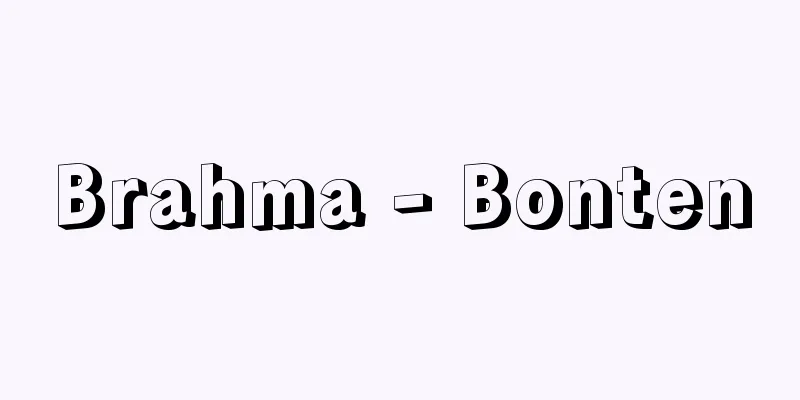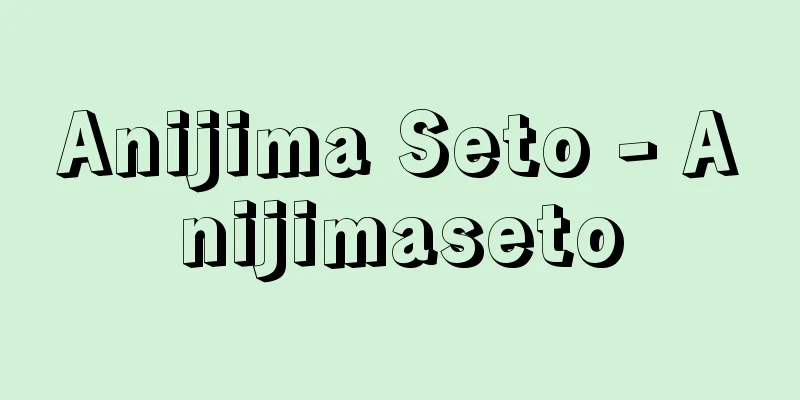Brahma - Bonten

|
[1] (Translation of Brahman. Formerly also called "Bonden") [1] A god revered as the creator of the world in ancient Indian religion. A deification of Brahman, which is considered the origin of the universe in ancient Indian thought. In Buddhism, he became a god who protects Buddhism and resides in Shozenten in the realm of form . One of the Twelve Heavenly Beings and the Eight Directional Heavenly Beings, he is often paired with Taishakuten. Great Brahma king. King of Brahma. [2] (From the meaning of "Brahma land" or "Indian land") An Indian title. ※Shobogenzo (1231-53) Dharani: "The words of human affairs are not transmitted from Brahma, nor from the Western Heaven, but are transmitted by the Buddha and the ancestors." [2] [Noun] ① Buddhist term. A general term for Shozenten in the realm of form. There are three heavenly beings: Daibonten, Bonfuten, and Bonshuten. Daibonten is the king of the Shozenten, Bonfuten is a vassal, and Bonshuten is the general public. *Ryōiki (810-824): "A mother loves her child, and so the child is born as Bonten." [Old Book of Tang - Tenjiku Kokuden] 2. A bundle of offerings used in Shugendō (mountaineering asceticism) . *Kayo-Rakuyoshu (1704), 7th Misegawa: "This is called Uzuki, and the bonden is very strong." 3. A stick with a sacred offering hanging from it. The meaning of hote ( a sign of possession) is linked to the word Bonten, and indicates a place where a god resides. In Akita Prefecture and other areas, there is a Bonten offering festival in which a firefighter's robe-like cedar log is carried to the local shrine. [Season: New Year] ④ A pole with many sacred wands stuck on it. In Edo city, many young people from each town made these during the Boys' Festival, and many mountain ascetics were hired to blow conches and distribute them to houses to hang on the eaves as a talisman. ⑤ A type of sacred wand used in the Edo period to ward off wind gods, demons, and insects. In addition to being brought by couriers and others when visiting shrines, they were also carried while waving them during festivals and erected at village borders. *Tangihon, Hikasa Zadan (1755), 3 "Use bonden to stroke the necks of everyone in the village" ⑥ In the early modern period, two maneki (beckoning poles) were erected on the left and right of a tower ( yagura) built on the roof of the main entrance to a theater. They were used to worship the Bonten King and were a sign of official approval. [The Beginning of Kabuki and Geisha (1762)] ⑦ Weaponry. A type of joinery. ⑧ A sign indicating the location of fishing gear. Used in longline and gillnet fishing. Commonly called "bonden." ⑨ A rolled straw sack with many skewers of fish stuck into it. Named after its resemblance to a sacred offering. Widely used to preserve and dry fish and other items, and to save space. Benkei. ※Zappai and Senryu Hyōmangū-Ago, Tenmei 5 (1785), Shingo "What a stingy tea to stick a fish in a bonten" ⑩ Abbreviation of "bontenuri (bonten gourd)." ※Goyudono Kami Nikki, Tenbun 4 (1535), June 20th "From my visit to Honten, I'm coming" ⑪ A duster. A duster. ※Fudemakase (1884-92) by Shiki Masaoka, vol. 2 “The broom called hatori in Tokyo is called bonden or gomiharai in Matsuyama.” Source: The Selected Edition of the Japanese Language Dictionary About the Selected Edition of the Japanese Language Dictionary Information |
|
[1] (Brahman の訳。古くは「ぼんでん」とも)[一] インドの古代宗教で、世界の創造主として尊崇された神。古代インド思想で宇宙の根源とされるブラフマンを神格化したもの。仏教にはいって色界(しきかい)の初禅天(しょぜんてん)に住する仏教護持の神となった。十二天、八方天の一つで、帝釈天と対をなすことが多い。大梵天王。梵天王。[二] (「梵土」「天竺」の意から) インドの称。※正法眼蔵(1231‐53)陀羅尼「人事の言は、〈略〉梵天より相伝せず、西天より相伝せず、仏祖より正伝せり」[2] 〘名〙① 仏語。色界の初禅天の総称。大梵天・梵輔天・梵衆天の三天があり、大梵天は初禅天の王、梵輔天は家臣、梵衆天は一般庶民に当たる。※霊異記(810‐824)中「母、子を慈び、因りて自から梵天に生まる」 〔旧唐書‐天竺国伝〕② 修験道(しゅげんどう)で祈祷に用いる幣束(へいそく)。※歌謡・落葉集(1704)七・三瀬川「此は卯月といふしでの、ぼんでんすごく立てならに」③ 棒の先から御幣を垂れ下げたもの。ほて(占有標)の意が梵天の語と結びついたもので、神の依代(よりしろ)を示す。秋田県その他で、杉丸太に火消のまとい状のものを土地の神社にかつぎ込む梵天奉納祭がある。《季・新年》④ 幣束を棒の先に多く刺したもの。江戸市中で、端午(たんご)の節供に町々の若者が多く作り、山伏を大勢雇いほら貝を吹かせ、家々に配って魔除けとして軒にささせたもの。⑤ 江戸時代、風神、悪魔、虫などを追い払うための一種の幣束。飛脚などの往来や参宮に持参するほか、祭礼の際に振りながら持って歩いたり、村境に建てたりする。※談義本・檠下雑談(1755)三「ぼんでんを以て、村中の者の首を撫」⑥ 近世、劇場正面入り口の屋上に設けた櫓(やぐら)の左右に立てた二本の招(まねき)。梵天王をまつり、官許のしるしとしたもの。〔歌舞妓事始(1762)〕⑦ 武具。指物の一種。⑧ 漁具の所在を示す標識。延縄(はえなわ)・刺網漁業で用いる。一般に「ぼんでん」という。⑨ 魚などをさした串を何本も突き立てる巻藁。幣束の形に似ているところからの名称。魚などの保存や乾燥、また場所をとらぬために広く利用された。弁慶。※雑俳・川柳評万句合‐天明五(1785)信五「ぼんてんに魚をさしとくけちな茶や」⑩ 「ぼんてんうり(梵天瓜)」の略。※御湯殿上日記‐天文四年(1535)六月二〇日「御いままいりよりほんてんまいる」⑪ はたき。ちり払い。※筆まかせ(1884‐92)〈正岡子規〉二「東京でいふハタキを松山にてはボンデン又はゴミハライといひしが」
出典 精選版 日本国語大辞典精選版 日本国語大辞典について 情報 |
>>: Bontebok (English spelling)
Recommend
Republic of the Gambia
A republic located at the western end of West Afr...
Franchise
...It is also characteristic of Japan that franch...
TVC
…However, graphite is often used for the throat, ...
North Dravidian - Kitadorabidago
...Central Dravidian languages include Kui (500...
Eisgruber, E.
...This was a time when cheap German lithographs ...
Big Program Traffic - Big Program Traffic
…This was called the Kamigata Zaibantō. For this ...
Each firefighter - Kakujibikeshi
…Furthermore, in 1717 (Kyoho 2), the shogunate re...
Canopus - Canopus (English spelling)
The proper name of the alpha star in the constell...
Nemuro Main Line - Nemurohonsen
The name of the Hokkaido Railway Company's tr...
Ookoshi Sakuemon
…Also, at that time, Japan's overall fishing ...
Yoshi Hijikata
Director. Real name Hisayoshi. Born in Tokyo on A...
Ryo no Gige - Ryo no Gige
This is an official commentary on the Yoro Code. ...
PA - Peace
An index showing the degree of effectiveness in b...
Electron Bolt
The electron volt is the amount of energy that an ...
Amagase [town] - Amagase
A former town in Hita County, western Oita Prefect...
![Joetsu [city] - Joetsu](/upload/images/67cbda79504a8.webp)








